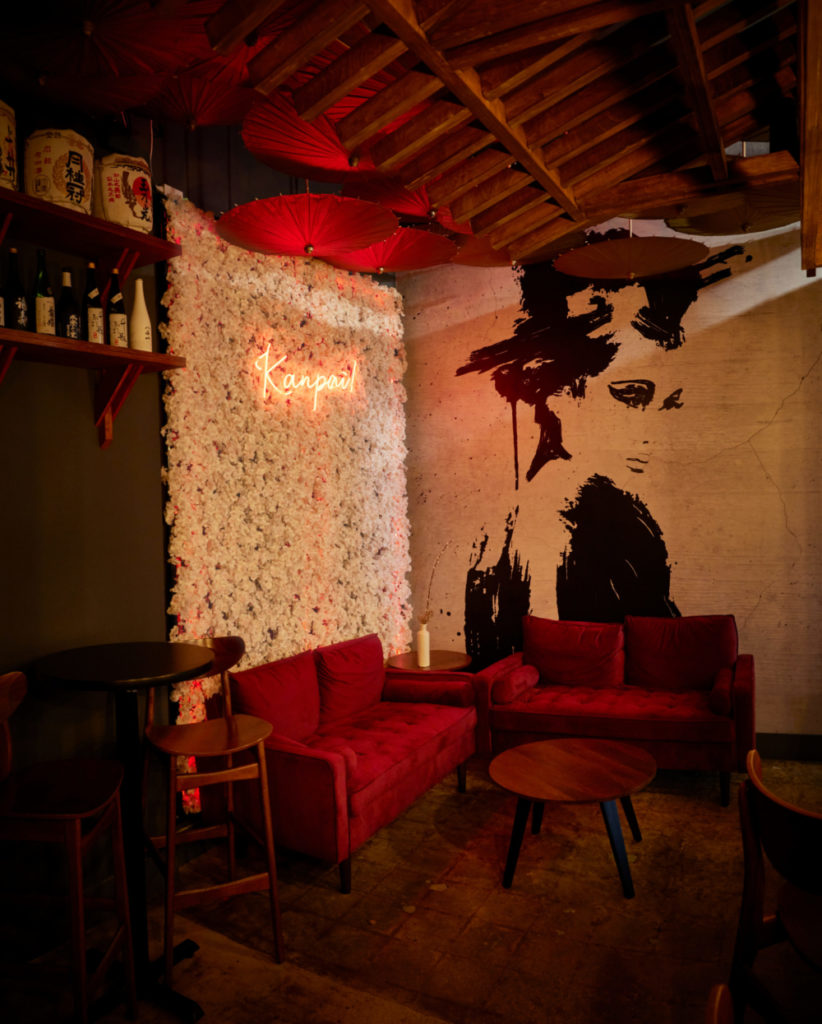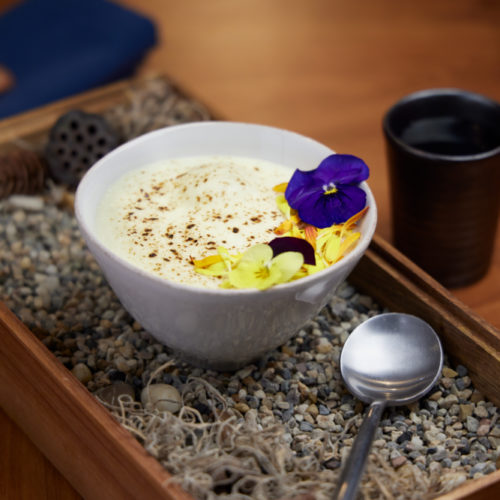Photographed by Andrew Meade
Loud, vibrant, and conspicuous, Miami is more known for multi-million-dollar restaurants than it is for hidden dining rooms or secret speakeasies. Influenced by both climate and cultures, it’s also a place where everything from appetizers to desserts trend toward the tropical rather than the velvety and cheesy.
At the year-old Kojin, located in the rapidly gentrifying Little River/El Portal neighborhood, chef-owners Pedro and Katherine Mederos defy those norms. A modest 10-seat restaurant located in the back of another restaurant, Hachidori Ramen Bar, Kojin was originally designed to be a sake den. Instead, Hachidori owner Guillermo Paniza started using it for storage while the pandemic raged and locals took advantage of the restaurant’s outdoor seating.

In June 2021, he reached out and offered the space to Pedro and Katherine, who had recently closed their four-month-old dumpling pop-up. With a wall of faux cherry blossoms and a neon kanpai sign already installed along with a bar and a table or two, Kojin was turnkey. All Pedro and Katherine had to do was move in—and figure out what they wanted to serve without having a full kitchen. You might think that the young couple, who had met at The Culinary Institute of America (CIA) at Greystone in St. Helena, California, would offer a variation on the classical French cuisine in which they were trained. Especially since they would have to use every inch of the bar, along with portable and makeshift appliances and burners at various prep stations.
Instead, Pedro, who has a sense of humor so deadpan that his words almost evaporate like dry ice, says, “We created this to make it as difficult for ourselves as possible. So now we work 12–14-hour days.” In other words, they went in a completely different direction: toward fare that the Miami-bred Pedro describes as “traditional Japanese with modern twists.”
Those little twists include touches like a kumquat kosho (pepper) gel to highlight a slice of kampachi, or celery root puree to underscore smoked Arctic char topped with a geometric mold of smoked trout roe and a sprig of marigold mint. Presentation is equally important, with displays of miso consommé poured from a teapot over tender clams, or lacto-fermented tomato water and green coriander oil carefully drizzled like raindrops onto a fresh nasturtium leaf, then from there over heirloom tomatoes and stone fruits.
Pedro picked up many of these techniques, along with a fondness for fermentation, from his externship at the three Michelin-starred restaurant Single Thread Farms and Inn in Healdsburg, California, which serves kaiseki (also known as kaiseki-ryri) cuisine. The western equivalent is nouvelle or haute cuisine, and they both showcase not only the fare but the skills of the chef—usually via a set menu.
At Kojin, the Maderos serve a six- or ten-course tasting menu, designed by Pedro and executed with the help of sous chef Raul Gonzales: They can obsessively supervise both input and output and, at the same time, keep a close eye on quality.
Menus change quarterly and showcase the training and technique drilled into the chefs at the CIA. The creativity comes in via the access they get to South Florida’s local farms, many of which grow Asian produce ranging from daikon radish and mustard greens to lychees and yuzu. Dishes on the tasting menus might start with A5 wagyu beef wrapped around maitake and king oyster mushroom duxelles and conclude with duck moistened by roasted jus and accompanied by hakurei turnips. One of Pedro’s signature specialties, chawanmushi, an egg custard encrusted with truffles and chives, almost always shows up in the middle of the meal.
Pastry chef Katherine’s desserts, usually an appealing choice of two rich but light constructions, might include her oft-requested Hokkaido tart. A deconstructed version of a popular Japanese dessert, it has a base of crumbled vanilla sable, or shortbread, and a hidden tablespoon of jam under a fluff of custardy cheese. The presentation is as beautiful as the rest of the dishes, the cloud of cheese freshened further with a rainbow of edible nasturtiums and pansies.
In other words, there’s plenty of umami heightened by luxe ingredients and competing textures to keep the palate—and the dining public—interested. In fact, the pair has proved so adept at winning over a customer base, even while operating from a “secret” back-door location, that Paniza asked them in early February to take over the kitchen and dining room at Hachidori as well.
 Pedro now directs the kitchen of the larger restaurant in addition to building his innovative tasting menus at Kojin. Meanwhile Katherine acts as general manager of both spaces and provides completely separate sweets for the two different identities.
Pedro now directs the kitchen of the larger restaurant in addition to building his innovative tasting menus at Kojin. Meanwhile Katherine acts as general manager of both spaces and provides completely separate sweets for the two different identities.
If that weren’t enough, the couple is also constructing a second restaurant not far from Kojin called The Barrister. With 14 counter seats, it will be similar in style and service to Kojin, but the fare will be modern American. And before The Barrister debuts in about 18 months, they’ll have their first child, which they’re currently expecting.
But while Pedro and Katherine already have a lot going on, it’s a good bet this talented chef duo is just getting started.

Hokkaido Cheese Tart
Ingredients
- 1¼ cups cream cheese room temperature
- ½ cup Greek yogurt
- 3.2 tablespoons (40 grams) grated parmesan cheese
- 4.2 tablespoons (40 grams) unsalted butter room temperature
- 1 cup (200 grams) whole milk
- 1 cup (120 grams) confectioners sugar
- 2 eggs
- 1 teaspoon vanilla extract
- ½ teaspoon salt
- ½ teaspoon lime juice
FOR SERVING
- shortbread cookies
- fruit jam or conserve
Instructions
- In a saucepan, heat cream cheese, Greek yogurt, parmesan cheese, butter, and milk over low heat. Cook until all ingredients have melted and are smooth, stirring with a wooden spoon constantly to ensure no burning.
- In a separate bowl, whisk together remaining ingredients. Pour half of hot cheese mixture into bowl, whisking into cold ingredients to temper them. Then whisk in remaining cheese mixture.
- Return everything to saucepan and cook over medium heat, stirring constantly to ensure no burning, until mixture thickens. Strain through a fine mesh strainer. Add to a whipped cream canister (such as iSi) and charge (optional).
- To serve, crumble shortbread cookies into a glass or other individual serving dish, add a tablespoon of fruit jam, then top with the cheese mixture (aerated or spooned into the bowl).




